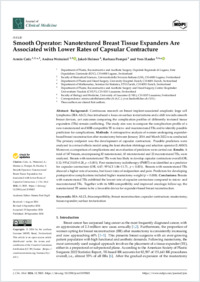Smooth operator : nanotextured breast tissue expanders are associated with lower rates of capsular contracture
- Catic, Armin ORCID Department of Plastic, Reconstructive and Aesthetic Surgery, Ospedale Regionale di Lugano, Ente Ospedaliero Cantonale (EOC), Lugano, Switzerland - Faculty of Biomedical Sciences, Università della Svizzera italiana, Switzerland
- Weinzierl, Andrea Department of Plastic and Hand Surgery, University Hospital Zurich, Switzerland
- Heimer, Jakob Department of Mathematics, Seminar for Statistics, ETH Zurich, Switzerland
- Pompei, Barbara Faculty of Biomedical Sciences, Università della Svizzera italiana, Switzerland
- Harder, Yves Department of Plastic, Reconstructive and Aesthetic Surgery and Hand Surgery, Centre Hospitalier Universitaire Vaudois (CHUV), Lausanne, Switzerland - Faculty of Biology and Medicine, University of Lausanne (UNIL), Switzerland
- 2024
Published in:
- Journal of Clinical Medicine. - 2024, vol. 13, no. 19, p. 5803
BIA-ALCL
Biocompatibility
Breast reconstruction
Capsular contracture
Mastectomy
Tissue expander
Surface texturization
English
ntroduced a focus on surface texturizations and a shift towards smooth breast devices, yet outcomes comparing the complication profiles of differently textured tissue expanders (TEs) remain conflicting. The study aim was to compare the complication profile of a new nanotextured and MRI-compatible TE to micro- and macrotextured TEs and to identify possible predictors for complications. Methods: A retrospective analysis of women undergoing expander-based breast reconstruction after mastectomy between January 2016 and March 2022 was conducted. The primary endpoint was the development of capsular contracture. Possible predictors were analyzed in a mixed-effects model using the least absolute shrinkage and selection operator (LASSO). Moreover, a comparison of complications and an evaluation of predictors were carried out. Results: A total of 147 breasts, encompassing 82 nanotextured, 43 microtextured and 22 macrotextured TEs, were analyzed. Breasts with nanotextured TEs were less likely to develop capsular contracture overall (OR, 0.12; 95%CI 0.05–0.28, p < 0.001). Post-mastectomy radiotherapy (PMRT) was identified as a predictor for capsular contracture (OR, 4.67; 95%CI 1.86–11.71, p < 0.001). Breasts with nanotextured TEs showed a higher rate of seroma, but lower rates of malposition and pain. Predictors for developing postoperative complications included higher mastectomy weight (p = 0.008). Conclusions: Breasts with nanotextured TEs exhibited the lowest rate of capsular contracture compared to micro- and macrotextured TEs. Together with its MRI-compatibility and improved oncologic follow-up, the nanotextured TE seems to be a favorable device for expander-based breast reconstruction.
- Collections
- Language
-
- English
- Classification
- Medicine
- License
- Open access status
- gold
- Identifiers
-
- DOI 10.3390/jcm13195803
- ARK ark:/12658/srd1332004
- Persistent URL
- https://n2t.net/ark:/12658/srd1332004
Statistics
Document views: 53
File downloads:
- Harder_2024_MDPI_jcm_Smooth operator: 30
